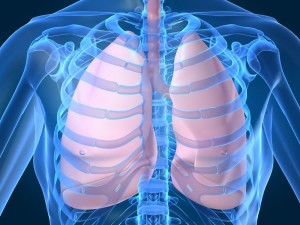Among patients with GERD seeking medical care in the United States, 20% have complications. Complications may occur inside or outside the esophagus. Complications may vary from mild esophagitis to major life-threatening problems such as recurrent pulmonary aspiration, Barrett’s esophagus and even esophageal cancer. The most common complication of GERD is esophagitis with mild inflammation. When severe it can progress to esophageal erosions, ulcerations that may bleed. Esophageal stricture occurs in up to 10% of patients who have reflux esophagitis, especially in older men. Esophageal strictures are often associated with the use of NSAIDs. An important and increasingly more common esophageal complication is Barrett’s esophagus, in which columnar lining cells replaces squamous type lining cells in the lower esophagus. It is a premalignant condition highly associated with the development of adenocarcinoma type cancer of the esophagus. It is found in approximately 10-15% of patients with GERD symptoms who undergo upper gastrointestinal (UGI) endoscopy. It is more common in older Caucasian men over the age of 60. Although its cause remains uncertain, acid reflux appears to injure the normal squamous lining cells and promote repair by changing to columnar lining cells. Because of the frequency and importance of Barrett’s esophagus, UGI endoscopy should be considered in all men with recurrent reflux symptoms. When found, continued endoscopic surveillance and aggressive measures are warranted to prevent cancer of the esophagus. Adenocarcinoma of the esophagus is among the fastest growing cancers by incidence in the United States where it has become the most common form of esophageal cancer. The incidence of adenocarcinoma in patients with Barrett’s esophagus is approximately 1% per year. Although the overall survival rate of patients with adenocarcinoma of the esophagus is less than 10%, those with early stage cancer identified in surveillance programs usually have a higher survival rate. 
Complications of GERD and their symptoms can occur outside the esophagus. These include atypical noncardiac chest pain, ear, nose, and throat (ENT) manifestations and lung problems. Atypical noncardiac chest pain has been related to GERD in up to 60% of cases and may often be indistinguishable from heart attack associated chest pain. Ear, nose, and throat (ENT) complications of GERD are frequent. Laryngitis is the most common ENT complication of GERD. In up to 10% of patients with hoarseness GERD is the cause. Acid injury can also cause globus sensation, which is a full feeling in the throat, ear, nose and throat infections, dental erosions, vocal cord granulomas and laryngeal cancer. Lung complications of GERD are common and include asthma, chronic cough, chronic bronchitis, pulmonary fibrosis, aspiration pneumonia and sleep apnea. In up to 21% of patients with chronic cough, GERD is the cause.
Diagnostic testing should be performed in patients in whom the diagnosis remains uncertain, in patients with atypical symptoms or warning symptoms that are often associated with complications, in patients who have an inadequate response to therapy and in patients prior to consideration of antireflux surgery. Barium swallow upper GI series and upper GI endoscopy are used to evaluate for swallowing difficulties and injury to the lining of the esophagus. Endoscopy is superior to the barium swallow exam. Capsule endoscopy, also called the pill camera, is evolving as a modality to evaluate the upper GI tract. In men with atypical symptoms or when quantification of reflux is required, ambulatory pH monitoring is helpful, now using wireless probes. Multichannel intraluminal impedance with pH sensor allows the detection of pH episodes irrespective of their pH values (acid and nonacid reflux. Esophageal manometry, measuring the pressures within the esophagus, is also sometimes used. A noninvasive test called the proton pump inhibitor (PPI) test has become a useful test in GERD patients for the evaluation atypical chest pain. Patients are given a course of high dose PPI agent, such as omeprazole and observed for improvement in their clinical response. In contrast to younger patients, endoscopy should be considered earlier as the initial diagnostic test in older men with heartburn, regardless of the severity or duration of complaints, because of the higher incidence of Barrett’s esophagus and esophageal cancer.




Comments are closed.